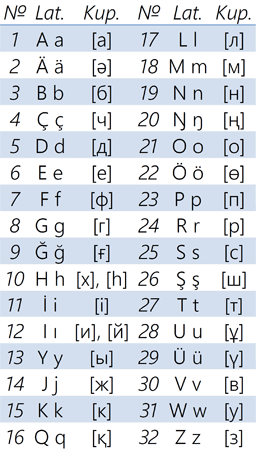Thursday 3 September 2020
No Hurry for the Transition to the Latin Alphabet in Kazakhstan
Keywords:
NUR-SULTAN / ex ASTANA (Satrapia) — Kazakh President Kassym-Jomart Tokayev estimates that the transition from the Kazakh alphabet (based on Cyrillic) to the Latin alphabet should be done without haste.

- Proposed Kazakh Latin alphabet
- Kazakh Latin alphabet, version presented on November 6 2019 by scientists from the Baitursynov Institute of Linguistics.
On the occasion of a meeting with the Minister of Culture and Sports Aktota Raimkulova, the Head of State of Kazakhstan clarified that he wanted the transition from the Kazakh alphabet to a Latin script to be done without haste, on the basis of a broad discussion on this issue with academics.
As part of a modernization program, an October 2017 Presidential Decree from Kazakh President Nursultan Nazarbayev ordered that the transition from Cyrillic to a Latin script be completed by 2025. The Kazakh Cyrillic alphabet is used in Kazakhstan and the Bayan-Ölgiy Province in Mongolia. It is also used by Kazakh populations in Kyrgyzstan, Russia, Turkmenistan and Uzbekistan, as well as Diasporas in other countries of the former USSR. It was introduced during the Russian Empire period in the 1800s, and then adapted by the Soviet Union in 1940.
A number of Latin alphabets are in use to write the Kazakh language. As with other Central Asian Turkic languages, a Latin alphabet, the Uniform Turkic Alphabet, was introduced by the Soviets and used from 1929 to 1940 when it was replaced with Cyrillic. Moreover, a Latin alphabet was used for the Kazakh language for Kazakhs in China during 1964–84. Later, the use of the Kazakh Arabic alphabet was restored in China.

